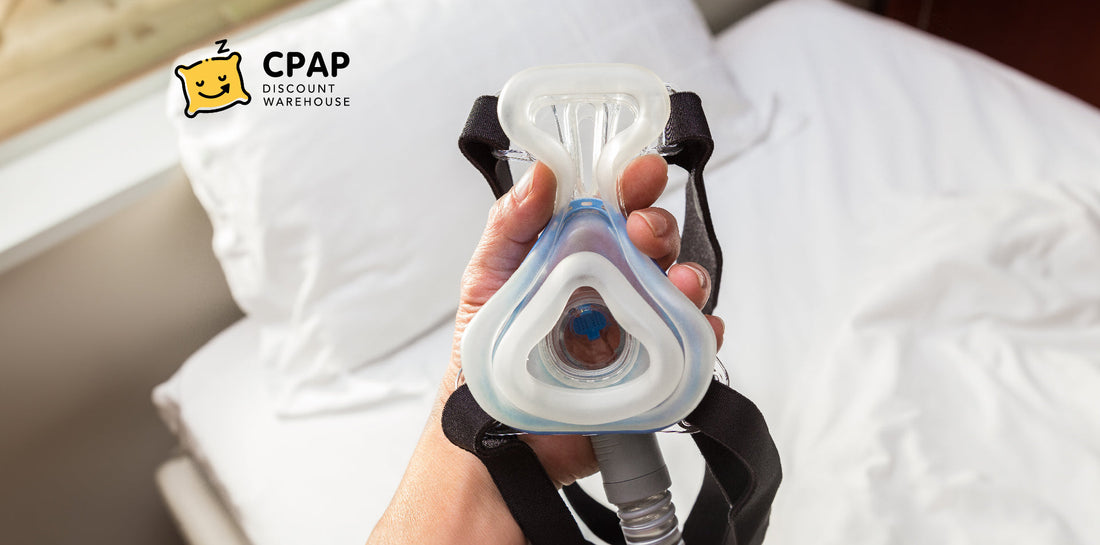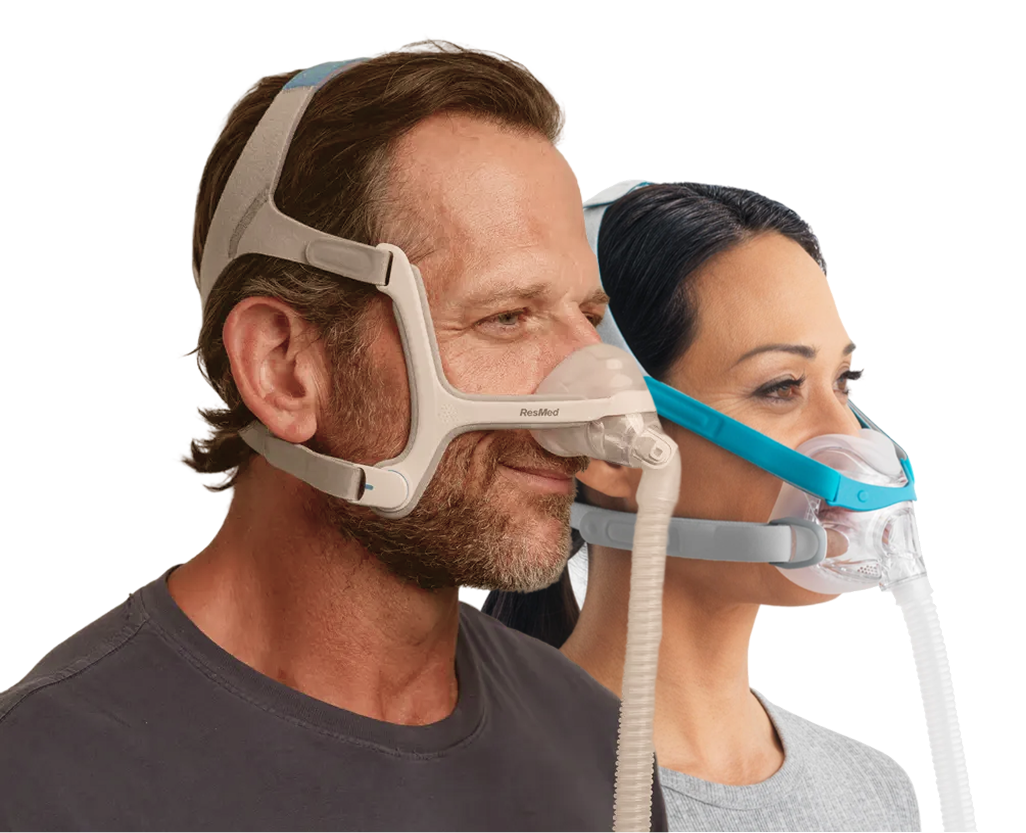Common side effects
Dry mouth and throat
Dry or runny nose
Dry eyes
Claustrophobia
CPAP Machine Noise
-
Machine Placement: Position the CPAP machine on a stable surface away from the bed to minimize vibrations and noise. Placing the machine on a carpet or soft surface can help absorb sound.
-
Machine Maintenance: Regularly clean and maintain the CPAP machine and its components to ensure smooth and quiet operation. Follow the manufacturer's guidelines for maintenance.
Irritant contact dermatitis
Headaches
Headaches are sometimes linked to incorrect CPAP pressure settings or sinus congestion caused by strong airflow. This can be more common during the first weeks of therapy. The best solution is to have your provider check pressure settings, especially if you are using a ResMed AirSense 10 or AirSense 11. Keeping filters clean and ensuring good air quality can further reduce sinus-related headaches.
Difficulty falling asleep
Adjusting to sleeping with a CPAP machine can take time, but a few strategies can help ease the transition.
Practice Wearing the Mask During the Day: Wearing your CPAP mask for short periods while awake can help you get used to its feel, making it more comfortable at bedtime.
Use the Ramp Feature: Many CPAP machines offer a ramp function that starts with lower air pressure and gradually increases to your prescribed setting as you fall asleep. This can make breathing feel more natural and reduce discomfort.
Follow Healthy Sleep Habits: Maintaining good sleep hygiene can improve your ability to fall asleep. Try to:
+ Exercise regularly, but avoid vigorous activity close to bedtime.
+ Limit caffeine and alcohol intake in the evening.
+ Establish a relaxing bedtime routine, such as taking a warm bath or reading.
+ Use a white noise machine if background noise helps you sleep.
With time and consistency, these adjustments can help you fall asleep more easily while using your CPAP machine, leading to better sleep and improved health.
Excessive gas and bloating
Some people experience bloating, burping, or stomach discomfort from swallowing air during CPAP therapy. This condition, called aerophagia, often results from high pressure settings. Adjusting the pressure with help from a provider or using features such as expiratory pressure relief (EPR) can make a big difference. Sleeping with your upper body slightly elevated may also ease symptoms.

Solutions to CPAP Problems
CPAP machine
CPAP machine is not working
Your CPAP machine won't turn on? Check the power cord, the outlet, and the power supply connection first. As with most electrical devices, we suggests using a different outlet to eliminate any electrical faults. ResMed AirSense 10 and AirSense 11 users should check that the power supply light is on and that the plug is firmly in place. If the machine will not power on, get in touch with the equipment provider or manufacturer for repair service.
CPAP machine is too noisy
Noise coming from a CPAP machine can be distracting and may signal a problem with the motor, tubing, or filter. ResMed suggests first checking that the air filter is clean and that the tubing is firmly connected. Positioning the machine on a flat, stable surface can also reduce vibration noise. If the sound increases over time, schedule a professional checkup to ensure the motor is functioning properly.
Getting tangled in your CPAP tube
Many patients report that their CPAP tubing wraps around them during sleep, interrupting rest. Manufacturers recommend using a tube management system or routing the tubing over the headboard to keep it out of the way. Lightweight and flexible tubing options, such as those from Fisher & Paykel, may also make movement easier. Consistently placing the tube in the same position each night can prevent tangling.
Keeping your CPAP from falling off the table
CPAP machines can sometimes slip or fall when placed on narrow or unstable nightstands. To prevent this, place the device on a wide, flat surface or consider positioning it on the floor beside the bed. Using a non-slip mat or anti-vibration pad under the machine can add stability. Both ResMed and Fisher & Paykel emphasize securing the machine to avoid damage and ensure safe operation.
Dry mouth and throat and a runny nose
If you still experience dryness or nasal discomfort despite using your CPAP, it may be related to mask leaks or humidifier settings. ResMed advises checking the water chamber daily and adjusting humidity levels for added comfort. Ensuring the mask is properly sealed can prevent air from escaping through the mouth. Using heated tubing can also stabilize airflow and reduce irritation.
CPAP humidifiers
Why should I guard against CPAP humidifier water spills?
Water spills can damage the CPAP device and increase the risk of electrical issues. ResMed recommends always removing the water chamber before moving the machine and ensuring it is seated correctly before use. Keeping the device on a stable, flat surface also helps avoid accidental tipping and leakage.
Why use distilled water for a CPAP machine?
Distilled water prevents mineral buildup inside the humidifier chamber and extends the life of the device. Tap water often contains minerals that can create scale, harbor bacteria, and damage the heating plate. Both Fisher & Paykel and ResMed recommend using distilled water daily to keep the humidifier clean and safe.
Do I need to clean the water chamber every day?
Daily cleaning of the water chamber is strongly advised by manufacturers. Rinse with mild soap and warm water, then allow the chamber to air dry before reassembly. This routine helps prevent mold, bacteria, and mineral residue from affecting your therapy.
CPAP masks
Why is my CPAP mask giving me a rash?
Skin irritation can result from poor cleaning, over-tightened straps, or a reaction to the mask material. ResMed suggests washing the mask daily with mild soap and water to remove oil buildup. If irritation continues, try mask liners or request a hypoallergenic mask option from your supplier.
Why do I keep taking my sleep mask off in my sleep?
Removing the mask unconsciously at night usually indicates discomfort or claustrophobia. One solution is to practice wearing the mask while awake, gradually increasing the time until it feels more natural. Fisher & Paykel also recommends experimenting with different mask sizes or types to improve comfort.
How to deal with CPAP claustrophobia?
Claustrophobia is a common challenge with full-face masks. Experts recommend gradual desensitization, such as wearing the mask during the day while reading or watching TV. Switching to a nasal pillow design or using relaxation exercises before bedtime can also reduce anxiety and improve compliance.
How to stop sore, swollen, and irritated puffy eyes from CPAP?
Eye problems usually occur when air leaks upward from the mask into the eyes. ResMed recommends adjusting the fit, replacing worn-out cushions, or choosing a different mask style to create a better seal. Mask liners may also help reduce leaks and protect sensitive skin around the eyes.
>>> Why does my CPAP mask get water in it?
CPAP functionality issues
Why is my humidifier not filling with water?
If the humidifier chamber does not fill, it may be inserted incorrectly or have a blockage. Check for cracks or leaks in the chamber and replace it if necessary. Always follow manufacturer instructions to ensure correct placement in the device.
Why is my ResMed CPAP humidifier not heating?
A humidifier that fails to heat could be due to a loose power connection or a faulty heating plate. Verify that the machine is connected properly and that the water chamber is seated correctly. If the issue continues, contact ResMed support for inspection or replacement.
Why is my CPAP machine getting noisier?
Over time, CPAP machines may produce more noise due to motor wear or clogged filters. Regularly replacing filters and cleaning the tubing can reduce unnecessary sounds. If the noise persists, consult your equipment provider to determine whether servicing or replacement is needed.






